To protect your POS network, regularly update and patch software and firmware, ensuring vulnerabilities are fixed quickly. Implement strong access controls with multi-factor authentication and role-based permissions. Use encryption protocols like TLS for data in transit and AES-256 for stored information. Segment your network to isolate POS systems from other business assets, and monitor activity continuously for threats. Strengthen physical security and establish incident response plans. Keep security standards compliant—you’ll discover more tips along the way.
Key Takeaways
- Regularly update and patch POS software, firmware, and network devices to fix vulnerabilities and prevent exploits.
- Implement strict access controls, multi-factor authentication, and role-based permissions to limit data access.
- Encrypt data at rest and in transit using protocols like TLS 1.3 and AES-256 for secure transmission and storage.
- Segment POS networks from other business systems and deploy firewalls, IDS/IPS to monitor traffic and block threats.
- Conduct routine security audits, vulnerability scans, and staff training to ensure ongoing compliance and threat detection.
Regularly Update and Patch POS Software and Firmware
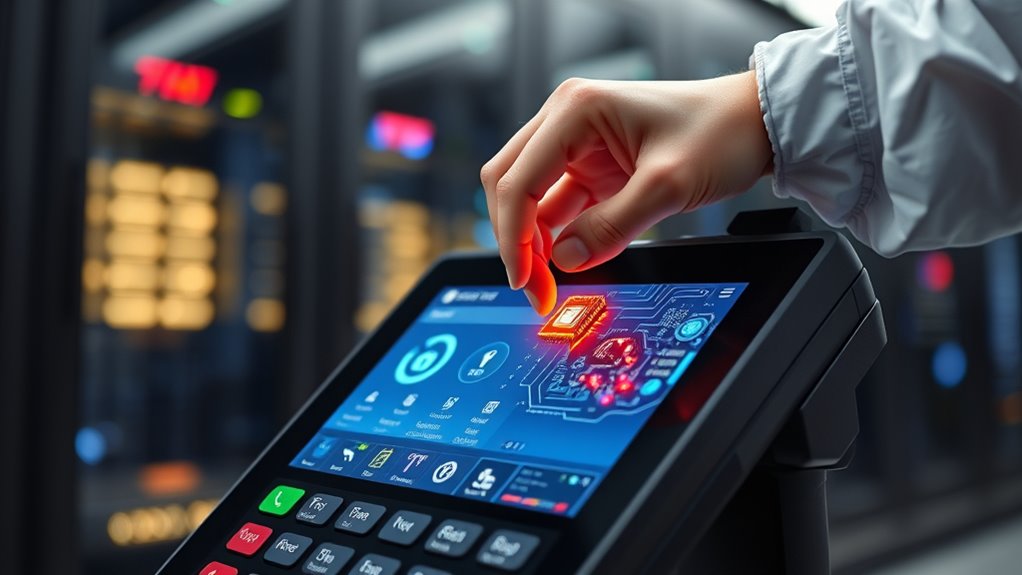
To protect your point-of-sale (POS) systems from cyber threats, it’s essential to regularly update and patch their software and firmware. Cybercriminals often exploit known vulnerabilities in outdated systems, so staying current minimizes this risk. Set up automatic updates whenever possible, ensuring patches are applied promptly. Regularly check for updates from your POS vendors and install them as soon as they’re available. Don’t ignore notifications or delay updates, as hackers can quickly target systems with unpatched vulnerabilities. Keeping your software and firmware current helps close security gaps, prevents malware infections, and maintains overall system integrity. On-device AI capabilities in newer hardware can also assist in monitoring for suspicious activity and potential security breaches. By making updates a routine part of your maintenance, you considerably reduce the chances of a costly breach impacting your business.
Implement Strong Access Controls and Authentication Measures
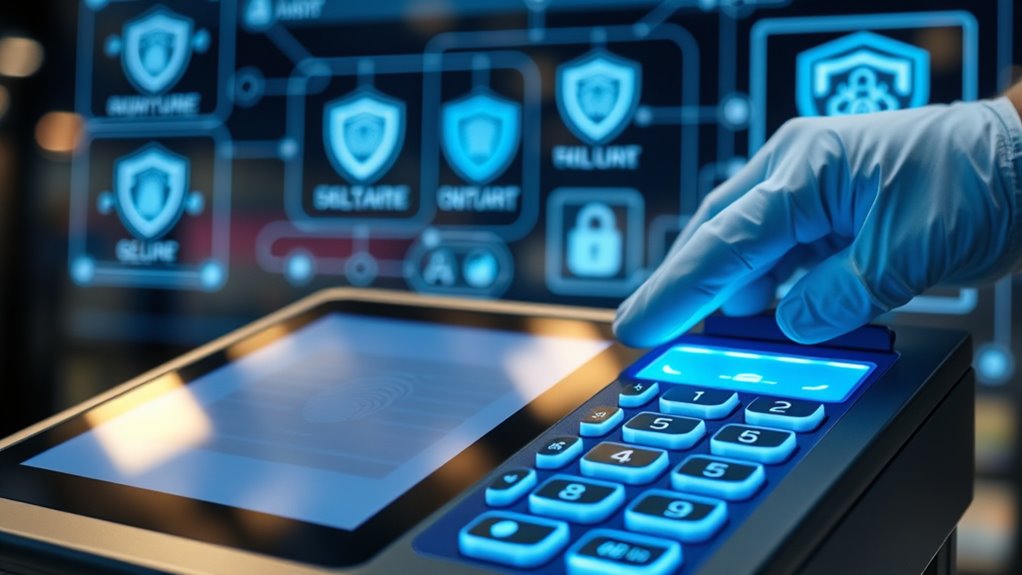
Keeping your POS systems secure involves more than just updates; strong access controls and authentication measures are vital in preventing unauthorized access. You should implement robust methods to verify user identity and limit system access. Consider these key steps:
- Use unique, complex passwords for each user account, avoiding default or easily guessable credentials.
- Enforce multi-factor authentication (MFA) to add an extra layer of security beyond passwords.
- Assign access levels based on roles, ensuring employees only access the data necessary for their job functions.
- Regularly review and update user permissions to prevent privilege creep. By applying these measures, you reduce the risk of insider threats and external breaches, keeping your POS network protected. Mindfulness can also help security teams maintain focus during complex access management tasks.
Use Encryption for Data Transmission and Storage
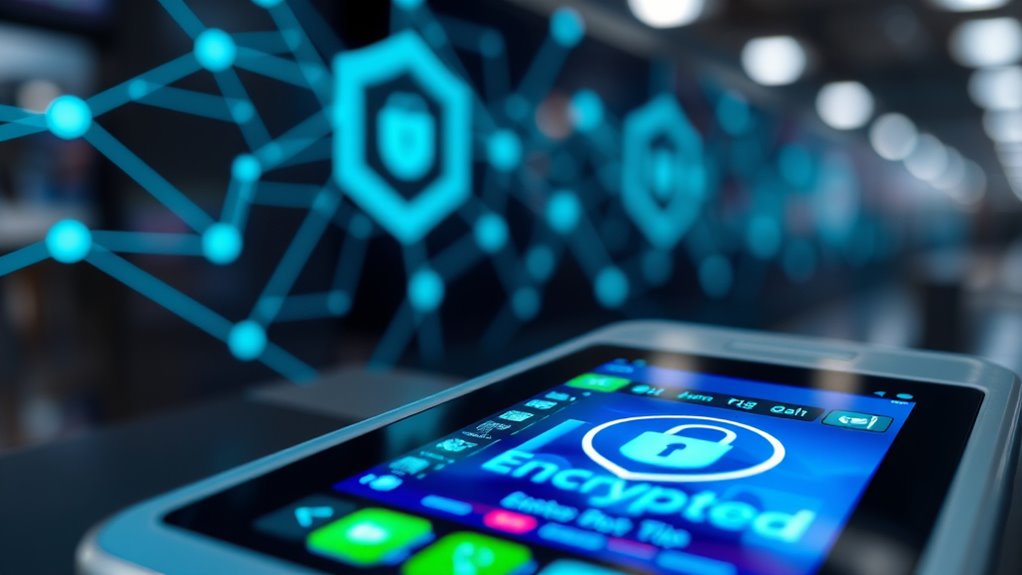
You should encrypt data both during transmission and when stored to protect it from unauthorized access. Using strong encryption protocols guarantees that sensitive information remains secure, even if intercepted or accessed without permission. Implementing these measures is essential for maintaining your data’s confidentiality and integrity. Additionally, understanding essential oils for respiratory health can aid in creating more holistic security practices by promoting well-being and stress reduction among staff.
Encrypt Data in Transit
Encrypting data in transit is essential to protect sensitive information from eavesdroppers and cybercriminals. Without encryption, data sent over networks can be intercepted and exploited. To guarantee security, follow these key practices:
- Use strong protocols like TLS 1.2 or higher to encrypt data during transmission.
- Implement VPNs for secure remote connections, creating an encrypted tunnel.
- Regularly update encryption tools and certificates to address vulnerabilities and maintain security standards.
- Educate users about emerging threats like cybersecurity vulnerabilities, which can be exploited during data transmission if proper encryption is not in place.
Secure Data at Rest
While encrypting data in transit protects information as it moves across networks, safeguarding data at rest prevents unauthorized access when storage media are compromised. To do this effectively, you should encrypt sensitive data stored on servers, hard drives, and backup media. Use strong encryption algorithms, such as AES-256, to guarantee data remains unreadable without the proper decryption keys. Implement access controls so only authorized personnel can decrypt and view the data. Regularly review and update encryption keys, and ensure that key management practices are secure. Encrypting data at rest reduces the risk of data exposure if devices are lost, stolen, or hacked. High contrast ratios play a vital role in ensuring that images remain clear and detailed, especially in dark scenes. This layer of security is essential for maintaining the integrity and confidentiality of your POS network’s sensitive information.
Use Strong Encryption Protocol
Implementing strong encryption protocols is essential to protect data both during transmission and when stored. By encrypting data, you guarantee that sensitive information remains unreadable if intercepted or accessed without authorization. To maximize security, consider these key steps:
- Use Up-to-Date Protocols: Implement protocols like TLS 1.3 for data in transit, ensuring robust encryption standards.
- Encrypt Data at Rest: Use strong algorithms such as AES-256 to protect stored data from unauthorized access.
- Manage Keys Securely: Store encryption keys in a secure environment, regularly rotate them, and limit access to prevent breaches.
Applying these practices helps safeguard customer data, maintains compliance, and reduces the risk of cyberattacks on your POS network.
Segment Your POS Network From Other Business Networks

You should separate your POS network from other business networks to reduce security risks. Implement network segmentation to isolate sensitive payment data and enforce strict access controls to limit who can reach it. This way, even if other parts of your network are compromised, your payment systems stay protected. Utilizing organic and natural juices as part of your wellness routine can also promote overall health, which supports better focus on cybersecurity practices.
Implement Network Segmentation
Segmenting your POS network from other business networks is a crucial step in safeguarding sensitive payment data. Proper segmentation limits access, reducing the risk of cyberattacks spreading through your systems. To implement effective network segmentation:
- Create separate VLANs or subnets for your POS systems, isolating them from administrative or guest networks.
- Use firewalls and access controls to restrict communication between segments, allowing only necessary data exchanges.
- Regularly monitor and audit network traffic to detect unusual activity or potential breaches early.
- Incorporate network segmentation best practices to further enhance your security posture.
Enforce Access Controls
How can you guarantee that only authorized personnel access your POS network? The key is enforcing strict access controls. Use strong passwords, multi-factor authentication, and role-based permissions to limit access. Segment your POS network from other business systems to prevent unauthorized reach. Regularly review and update access rights to ensure only current staff can connect. Make sure network devices are protected with firewalls and encryption. Implementing a Gold IRA Rollovers strategy can also enhance your overall security posture. Here’s an example of access levels:
| Role | Access Rights | Example Permissions |
|---|---|---|
| Cashier | Limited POS access | Process transactions |
| Manager | Full POS & admin rights | Approve refunds |
| IT Staff | Network & security controls | Manage firewalls, updates |
Conduct Continuous Monitoring and Threat Detection

Continuous monitoring and threat detection are essential for maintaining a strong cybersecurity posture, as threats are constantly evolving and can strike at any moment. To stay ahead, you need to implement effective tools and strategies. First, deploy real-time monitoring systems that continuously analyze network traffic and user activity. Second, establish automated alerts for suspicious behavior or anomalies that could indicate a breach. Third, regularly review logs and conduct vulnerability scans to identify weaknesses before attackers do. By actively tracking potential threats and responding swiftly, you reduce your risk of data theft or system compromise. Additionally, understanding Glycolic Acid Exfoliating Toner can help inform best practices for skin safety when using various skincare products. This proactive approach helps you identify threats early, minimize downtime, and strengthen your overall security defenses. Staying vigilant ensures your POS network remains resilient against emerging cyber threats.
Train Staff on Cybersecurity Awareness and Best Practices
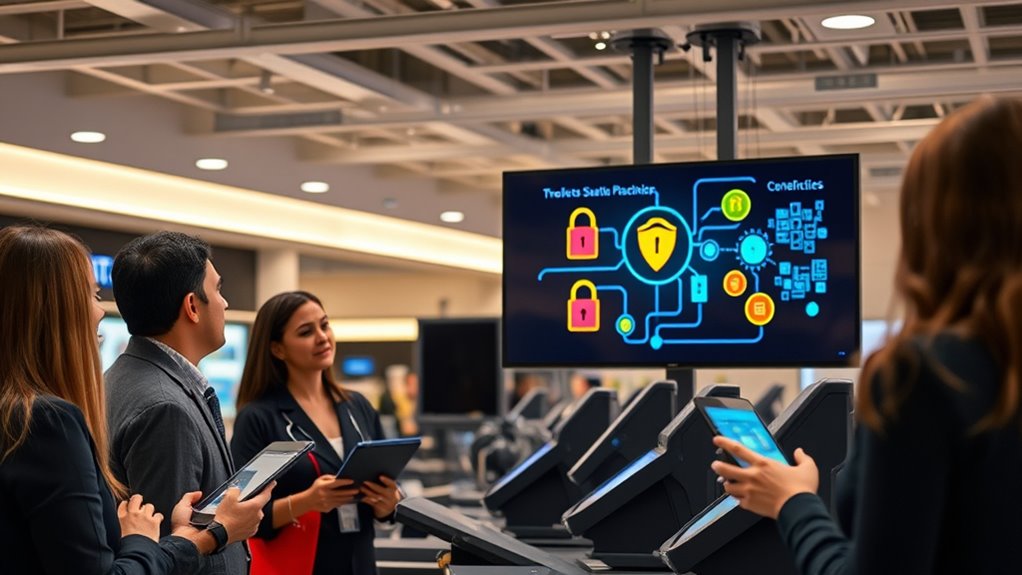
Since human error remains one of the biggest cybersecurity vulnerabilities, training staff on awareness and best practices is essential. You should regularly educate your team on recognizing phishing emails, suspicious links, and social engineering attempts. Make sure they understand the importance of strong, unique passwords and the necessity of multi-factor authentication. Encourage a culture of vigilance where employees report unusual activity immediately. Provide clear guidelines on handling sensitive customer data and avoiding risky behaviors, such as sharing login credentials. Conduct periodic training sessions and simulated security exercises to reinforce knowledge. Understanding the importance of security awareness training can significantly reduce the risk of breaches caused by human mistakes, helping to protect your POS network from potential threats.
Maintain Robust Physical Security for POS Devices
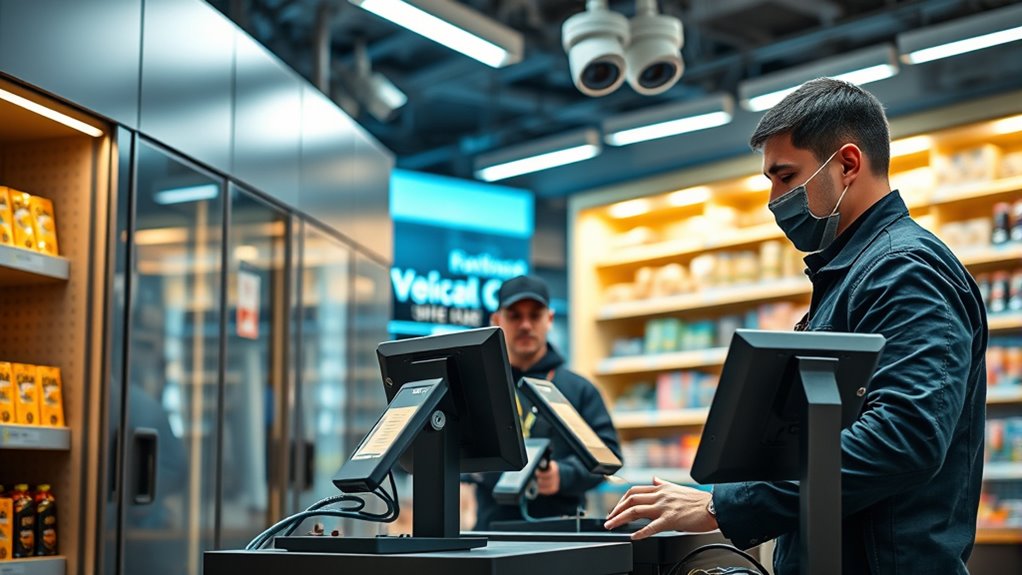
You need to control physical access to your POS devices to prevent theft or tampering. Regular inspections help identify vulnerabilities before they become serious issues. Using tamper-evident seals adds an extra layer of security and peace of mind.
Secure Physical Access
Securing physical access to POS devices is essential to prevent unauthorized tampering or theft. You need to implement strict controls to safeguard your equipment. First, limit access to authorized personnel only, using key cards or biometric systems. Second, position POS devices in secure, monitored areas to deter physical attacks. Third, ensure all access points have locks and are regularly audited for security breaches. By controlling who can reach your devices and where they’re located, you reduce the risk of physical tampering and theft. These measures help maintain the integrity of your POS network and protect sensitive data from physical threats. Remember, physical security is a critical layer of your overall cybersecurity strategy. Properly securing your POS devices ensures your business stays safe from physical vulnerabilities.
Regular Device Inspections
Regular device inspections are essential for maintaining the physical security of your POS systems. You should routinely check all devices for signs of tampering, damage, or unauthorized modifications. Ensure that all connections, cables, and power sources are secure and intact. Look for any unusual wear or damage that could indicate tampering or neglect. Confirm that all security features, such as locks or enclosures, are functioning properly and haven’t been compromised. Document your inspections to track the condition of each device over time. Regular checks help identify potential vulnerabilities early, preventing theft or malicious interference. By staying vigilant and proactive, you minimize the risk of physical breaches that could compromise sensitive payment data or disrupt your operations.
Use Tamper-Evident Seals
Implementing tamper-evident seals on POS devices is a proactive step to maintain physical security. These seals help you quickly identify if someone has interfered with your equipment. To maximize their effectiveness, consider these key actions:
- Place seals on all access points, including card readers and cash drawers.
- Regularly inspect seals for signs of damage or tampering, recording findings for accountability.
- Replace seals immediately if they are broken or compromised to ensure ongoing security.
Using tamper-evident seals creates a visual barrier that discourages unauthorized access. They serve as an early warning system, helping you detect potential threats before data or funds are compromised. Consistent application and inspection of seals strengthen your overall physical security posture.
Establish Incident Response and Data Breach Procedures

To effectively manage cybersecurity incidents, you need to establish clear incident response and data breach procedures. Start by creating a detailed plan that outlines how to detect, contain, and eliminate threats quickly. Assign roles and responsibilities to your team so everyone knows their tasks during an incident. Ensure you have a communication protocol to notify affected parties and regulatory authorities promptly. Regularly train staff on recognizing security breaches and following response steps. Keep documentation of incidents and responses for review and compliance. Having predefined procedures minimizes confusion and reduces response time, helping you limit damage and protect sensitive customer data. Review and update your plan periodically to address evolving threats and ensure your team remains prepared.
Conduct Periodic Security Audits and Vulnerability Assessments

Conducting periodic security audits and vulnerability assessments is essential to identify weaknesses before malicious actors can exploit them. Regular reviews help you stay ahead of potential threats and ensure your POS network remains secure. Focus on these key actions:
Regular security audits identify vulnerabilities before attackers can exploit them.
- Scan for vulnerabilities using automated tools to detect weak spots in your systems and software.
- Review access controls to ensure only authorized personnel have sensitive system permissions.
- Test your defenses through simulated attacks or penetration testing to evaluate your security posture.
Enforce Secure Payment Card Industry (PCI) Compliance
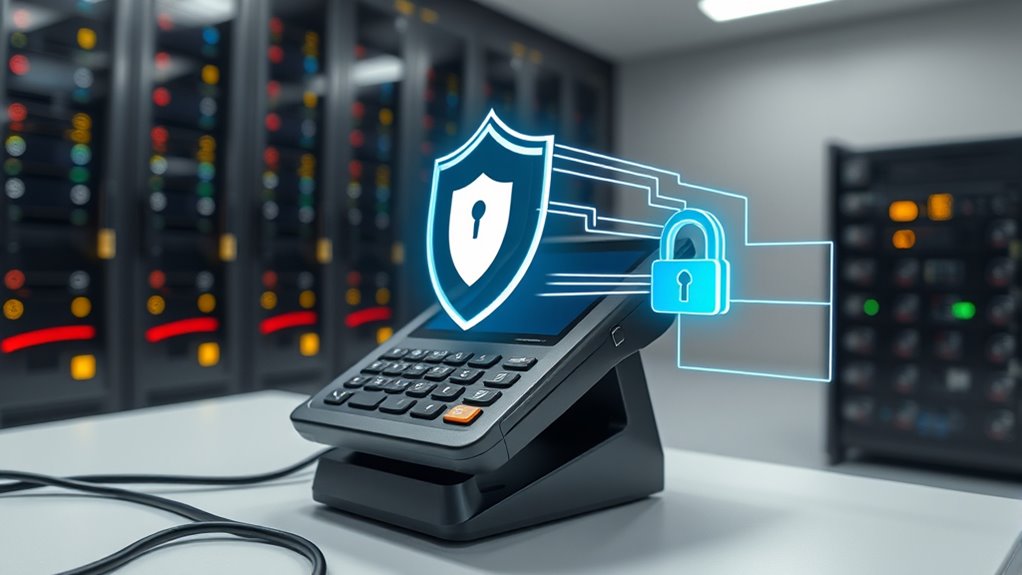
Enforcing Payment Card Industry (PCI) compliance is essential for safeguarding cardholder data and maintaining customer trust. You must follow PCI Data Security Standard (DSS) requirements, which include secure network architecture, encryption, and access controls. Regularly review your policies to guarantee they meet evolving standards. Training staff on PCI compliance helps prevent accidental breaches. Use the table below to visualize key PCI requirements:
| Requirement | Action | Outcome |
|---|---|---|
| Secure Network | Implement firewalls and segmentation | Prevent unauthorized access |
| Data Encryption | Encrypt cardholder data at rest and transit | Protects data integrity |
| Access Controls | Limit and monitor user access | Reduces insider threats |
| Regular Testing | Conduct vulnerability scans and audits | Ensures ongoing compliance |
Staying compliant minimizes risks and enhances your security posture.
Frequently Asked Questions
How Often Should POS Systems Be Audited for Vulnerabilities?
You should audit your POS systems regularly to identify vulnerabilities before they can be exploited. Experts recommend conducting vulnerability scans at least quarterly and after any significant system updates or changes. Regular audits help you stay ahead of potential threats and guarantee compliance with security standards. By staying proactive, you minimize risks, protect customer data, and maintain your business’s reputation. Don’t wait for an incident—make vulnerability assessments a routine part of your security strategy.
What Are the Latest Encryption Standards for POS Data Security?
Imagine a small retail shop upgrading its POS system, adopting the latest encryption standards like AES-256. This advanced encryption ensures that cardholder data stays protected during transactions, even if hackers intercept it. Currently, AES-256 is widely recognized as a top standard for POS data security. By implementing it, you markedly reduce the risk of data breaches, safeguarding customer information and maintaining trust.
How Can Small Businesses Effectively Manage POS Cybersecurity Risks?
To effectively manage POS cybersecurity risks, you should start by implementing strong, updated encryption standards to protect card data. Regularly update your POS software and firmware to patch vulnerabilities. Train your staff on security best practices, like recognizing phishing attempts. Use strong passwords and multi-factor authentication. Monitor your network for suspicious activity, and make certain your backup and recovery plans are in place. These steps help keep your business safe from threats.
What Are Common Signs of a POS Malware Infection?
You should watch for signs of POS malware infection, like unusual system slowdowns or frequent crashes. If you notice unexpected pop-ups or unauthorized transactions, it’s a red flag. Also, monitor for strange network activity or unexplained data transfers. These signs indicate malware might be lurking, putting your customer data at risk. Regularly updating your software and running security scans can help catch these issues early and keep your POS system safe.
How Does Employee Turnover Impact POS Network Security?
Think of your POS network as a well-guarded castle. When employee turnover is high, it’s like losing trusted knights; new staff may not be fully trained on security protocols, creating vulnerabilities. You might unknowingly grant access to sensitive data or leave gaps in your defenses. To keep your castle secure, make certain of thorough onboarding, regular training, and revoke access promptly when employees leave. This proactive approach keeps your network safe from potential threats.
Conclusion
By following these best practices, you can substantially reduce your POS network’s vulnerabilities and protect your customers’ sensitive data. Regular updates, strong access controls, encryption, and continuous monitoring are vital steps in this process. Are you willing to risk your reputation and customer trust by neglecting these essential security measures? Take action now to safeguard your business and guarantee peace of mind—because the safety of your customers and your reputation depends on it.









